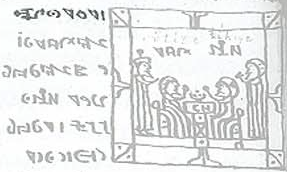The following depiction of the crucifixion is accompanied by text in which there are two characters that look like the cross itself. I have highlighted one of them, which is accompanied by a prefixed character that curves over it:
Note that the preposition "on" looks like an uncrossed version of the number nine. One possible way to interpret this is to say that the preposition here is Albanian në, "on", and by crossing the line it is changed to nëntë, "nine". For this gloss, and others in this post, I'll indicate how the phrase would read in Modern Albanian, Romanian, Hungarian and Croatian, for comparison.
A: në kryq
R: pe cruce
H: a kereszten
C: na križu
on the cross
In this case, the "on" is followed by the number "three". Since we know that Jesus rose on the third day, it would make sense that this could mean "on the third day" or "in three days":
A: në tre ditë
R: în tre zile
H: három nap alatt
C: u tri dana
in three days
A: në ditën e tretë
R: în a treia zi
H: a harmadik napon
C: trećeg dana
on the third day
If we can read the triangle and circle as "day", then that may work with the formula shown in the following image. This formula occurs at the beginning of many episodes in the text:
This last image holds a wealth of possibility. It shows a meeting between Jesus and someone whose name or title is given above his head. This name or title shares two characters with the opening formula, including the first character for the word "day". If the underlying language is Albanian or South Slavic, we would expect the person to have a d near the end of his name. If it is Romanian, we would expect a z, and if Hungarian an n.





No comments:
Post a Comment